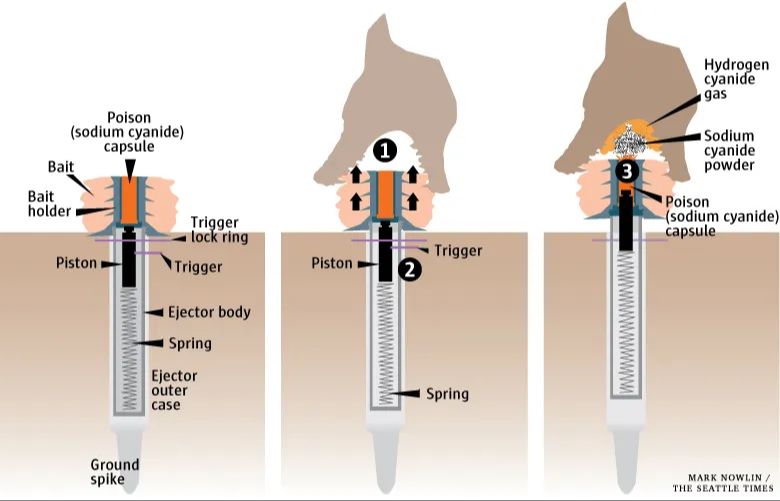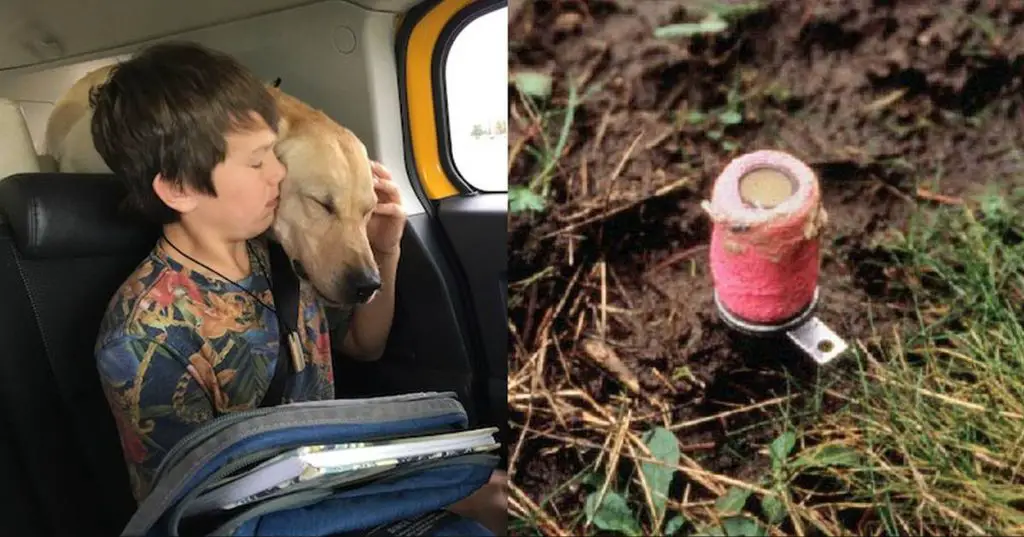Introduction
In March 2017, a horrific incident occurred in Pocatello, Idaho that brought national attention to the controversial use of cyanide traps by the U.S. Department of Agriculture. 14-year-old Canyon Mansfield was out walking his 3-year-old Labrador retriever, Casey, on public land near his house when Casey suddenly began convulsing and foaming at the mouth. The dog died right in front of Canyon, who had no idea what had caused his beloved pet’s demise. What authorities discovered was shocking and enraged many animal lovers and environmentalists across the country – Casey had been killed by ingesting poison from an M-44 cyanide trap set in the area. This device, also known as a “cyanide bomb”, was placed by Wildlife Services, a branch of the USDA tasked with controlling predators. The incident highlighted the potential dangers these devices pose not only to domestic animals, but also to threatened and endangered species. It reignited the debate around the ethics and necessity of using such a lethal method for wildlife management.
Background on the Story
In March 2017, a horrific incident occurred near Pocatello, Idaho involving a 14-year-old boy named Canyon Mansfield and his 3-year-old yellow Labrador retriever named Casey. Canyon was taking Casey on a walk near his backyard when he spotted a strange device on the ground that looked like a sprinkler head. When he bent down to examine it, the device exploded and sprayed cyanide in his face and on his dog (https://www.washingtonpost.com/news/politics/wp/2017/03/21/a-dog-in-idaho-was-killed-by-a-cyanide-trap-laid-by-the-u-s-government/).

Canyon was knocked to the ground by the force of the explosion. When he recovered, he saw that his beloved dog Casey was dying in front of him. The cyanide trap had sprayed poison directly into the dog’s mouth, killing him almost instantly. Canyon tried desperately to wash out Casey’s mouth and keep him alive, but it was too late. He had to watch helplessly as his dog convulsed and died on the hillside near their home (https://www.cnn.com/videos/us/2017/03/23/usda-cyanide-trap-dog-death-orig-vstan.cnn).
Details of the Incident
In March 2017, a 14-year-old boy named Canyon Mansfield was walking his 3-year-old labrador retriever named Casey near his home in Pocatello, Idaho when Casey suddenly collapsed and began to convulse (1). The dog died within minutes. Mansfield looked around to figure out what had caused Casey’s death and found an M-44 cyanide trap set by the United States Department of Agriculture (USDA) just steps away from the path where he and Casey had been walking. The cyanide trap was meant to control coyote populations but instead took the life of Mansfield’s beloved dog.
M-44s are spring-activated devices that release a deadly dose of powdered cyanide when they are triggered. The traps are most often set up near property inhabited by livestock like sheep and cattle. When an animal tugs on the baited M-44 stake with its mouth, the spring-loaded ejector releases cyanide powder into its mouth, nose, and eyes leading to a quick death (2).
Response from the Boy and Family
The boy, Canyon Mansfield, was out playing with his 3-year-old yellow Labrador, Casey, behind his house in Pocatello when he encountered the cyanide trap (Huffington Post). Canyon watched helplessly as his dog Casey died in front of him after triggering the cyanide trap. The family was devastated by the loss of Casey.
“Canyon Mansfield watched his dog, Casey, die in front of him,” said Theresa Mansfield, Canyon’s mother (Huffington Post). “We are taking on this issue for Canyon and for other families out there who should not be afraid to play fetch with their beloved family pets in their own backyards.”
The Mansfield family said the government needs to stop using these dangerous traps on public lands. “We understand there needs to be certain protections in place regarding predatory animals on public lands,” said Mark Mansfield, Canyon’s father. “But using these lethal toxins without notification to the public needs to be stopped immediately. We will be carrying on for Canyon” (Huffington Post).
USDA’s Use of Cyanide Traps
The USDA’s Animal and Plant Health Inspection Service (APHIS) division has used M-44 cyanide traps since the 1970s as a method of predator control for protecting livestock. These spring-loaded devices eject a deadly dose of sodium cyanide powder when triggered by coyotes, foxes and other wild canids. According to the USDA[1], the traps help control predation on livestock while also protecting certain threatened and endangered species.

The M-44 is designed to lure canids in with bait and then eject sodium cyanide into their mouth when bitten, which causes almost immediate death. The USDA defends their use as an important tool for managing wild predator populations in order to reduce attacks on livestock. However, conservation groups argue the indiscriminate nature of the traps makes them dangerous to pets and protected wildlife species.
The use of M-44s is regulated under the Federal Insecticide, Fungicide, and Rodenticide Act (FIFRA). All APHIS employees who deploy traps must undergo training and follow guidelines on their placement and monitoring. The agency also contends that human exposure risk is low if proper protocols are followed.
Regulations Around Trap Usage
The USDA’s Wildlife Services program is authorized to use M-44 cyanide traps to control predators like coyotes and foxes under the Federal Insecticide, Fungicide, and Rodenticide Act (FIFRA). However, there are certain regulations around their use:
Traps must be set at least 50 feet from any public road or pathway and have elevated warning signs posted within 15 feet (Source: https://www.biologicaldiversity.org/campaigns/cyanide_bombs/). The trap that killed the boy’s dog was near a hiking trail, violating this rule.
All traps must be “checked and maintained at regular intervals of not more than 30 days” (Source: https://apnews.com/article/coyotes-predators-cyanide-bomb-ban-federal-agency-6eae88fc23549b26d1b0751f0cc0f42c). Some argue the USDA does not properly maintain or monitor traps.
Traps cannot be used in areas where federally protected endangered species may be present unless authorized by the U.S. Fish and Wildlife Service (Source: https://awionline.org/press-releases/bill-reintroduced-ban-deadly-cyanide-bombs-public-lands). Conservation groups claim the USDA has violated this.
Backlash Against the USDA
The incident sparked major public backlash against the USDA’s use of M-44 cyanide traps. Many people were outraged that such dangerous devices were being used on public lands where pets like Canyon could accidentally come across them. According to the Seattle Times, over 250,000 people signed a petition calling for a ban on the traps after Canyon’s death.
Multiple environmental and animal rights groups spoke out against the traps, including the Center for Biological Diversity and WildEarth Guardians. They argued that the risks to pets and people outweighed any benefits from predator control. Some also pointed out that more humane, nonlethal methods were available to manage coyotes and other predators. As reported by the Vail Daily, WildEarth Guardians filed a lawsuit in 2017 trying to end the use of M-44s nationwide.
The public response put major pressure on the USDA and other agencies to reevaluate their policies. In 2017, the EPA imposed some tighter restrictions on when and how the cyanide traps could be used in response to the demands for change. But many felt these small steps weren’t enough. According to the AWIONline, Oregon Senator Jeff Merkley introduced federal legislation in 2023 trying to completely ban the use of M-44 devices on public lands.
Defense of Trap Usage
While the M-44s have generated controversy, supporters argue the traps help protect livestock and native wildlife populations. The USDA maintains the devices are an important tool for reducing conflicts caused by predators like coyotes and foxes. They contend the traps allow for targeted removal of specific problem animals rather than widespread killing.

Many ranchers and farmers have voiced support for keeping M-44s legal. They believe the traps help protect their livelihood by reducing livestock losses from predation. The American Sheep Industry Association has stated that banning M-44s would negatively impact sheep producers. They argue there are limited effective non-lethal options for controlling predators.
Some wildlife officials also defend the use of M-44s in specific circumstances. They say the traps can help conserve populations of rare or threatened species that are vulnerable to coyote predation. For example, black-footed ferrets and sage grouse have benefitted from coyote control efforts involving M-44s in certain areas, according to proponents.
While alternative methods like guard dogs, fencing and scare tactics exist, advocates say lethal traps remain the most cost-effective approach especially across larger landscapes. They emphasize proper precautions can minimize risks to pets and people.
The Future of Cyanide Traps
The future of cyanide traps on public lands remains uncertain amid ongoing debate. In June 2023, Senator Jeff Merkley (D-OR) reintroduced the Cyanide Bomb Ban Act, which would ban the use of M-44 cyanide devices on federal public lands (https://awionline.org/press-releases/bill-reintroduced-ban-deadly-cyanide-bombs-public-lands). This followed numerous calls for banning the traps after the incident involving the boy’s dog. However, the livestock industry has pushed back, arguing the traps are an important tool for protecting livestock from predators. The Biden administration put a temporary ban on trap use in 2021, but later reinstated their use in limited circumstances. The EPA also recently authorized their continued use.
In November 2022, the Bureau of Land Management announced it would cease using M-44s on federal public lands in a major policy reversal (https://www.sandiegouniontribune.com/business/nation/story/2023-11-28/us-agency-to-end-use-of-cyanide-bomb-to-kill-coyotes-and-other-predators-citing-safety-concerns). However, state agencies and private livestock producers can still use them. Some states like Oregon and Colorado have passed laws restricting trap usage while others like Montana still allow broad usage. It remains to be seen whether a nationwide federal ban will be implemented given the ongoing back-and-forth on the issue.
Conclusion

In summary, the use of cyanide traps by the USDA has been highly controversial. While the agency argues these traps are necessary to control predators that threaten livestock, their indiscriminate nature results in unintended cruelty to pets and endangered wildlife. The incident where a cyanide trap killed a boy’s pet dog brought national attention to this issue. In response, the USDA temporarily halted certain uses of the traps, but their future remains uncertain. This case highlights the difficult balance between agricultural interests and environmental protection. While ranchers have a valid need to protect their livestock, the costs of using inhumane traps that kill indiscriminately may be too high. As this debate continues, compromise solutions should be sought that protect both livestock and wildlife while avoiding needless animal suffering. This complex issue has no easy answers, but progress requires acknowledging concerns on all sides to find a humane way forward.